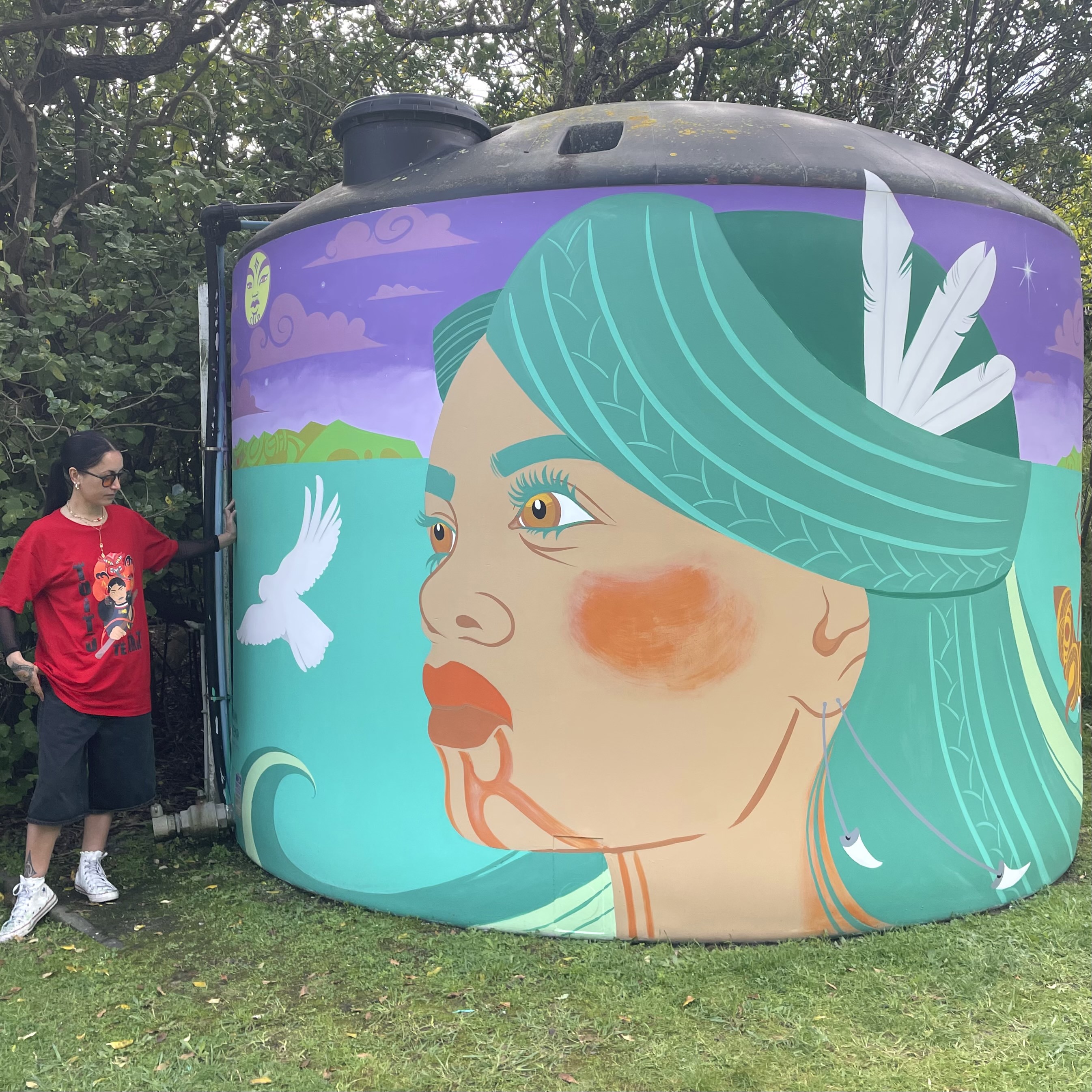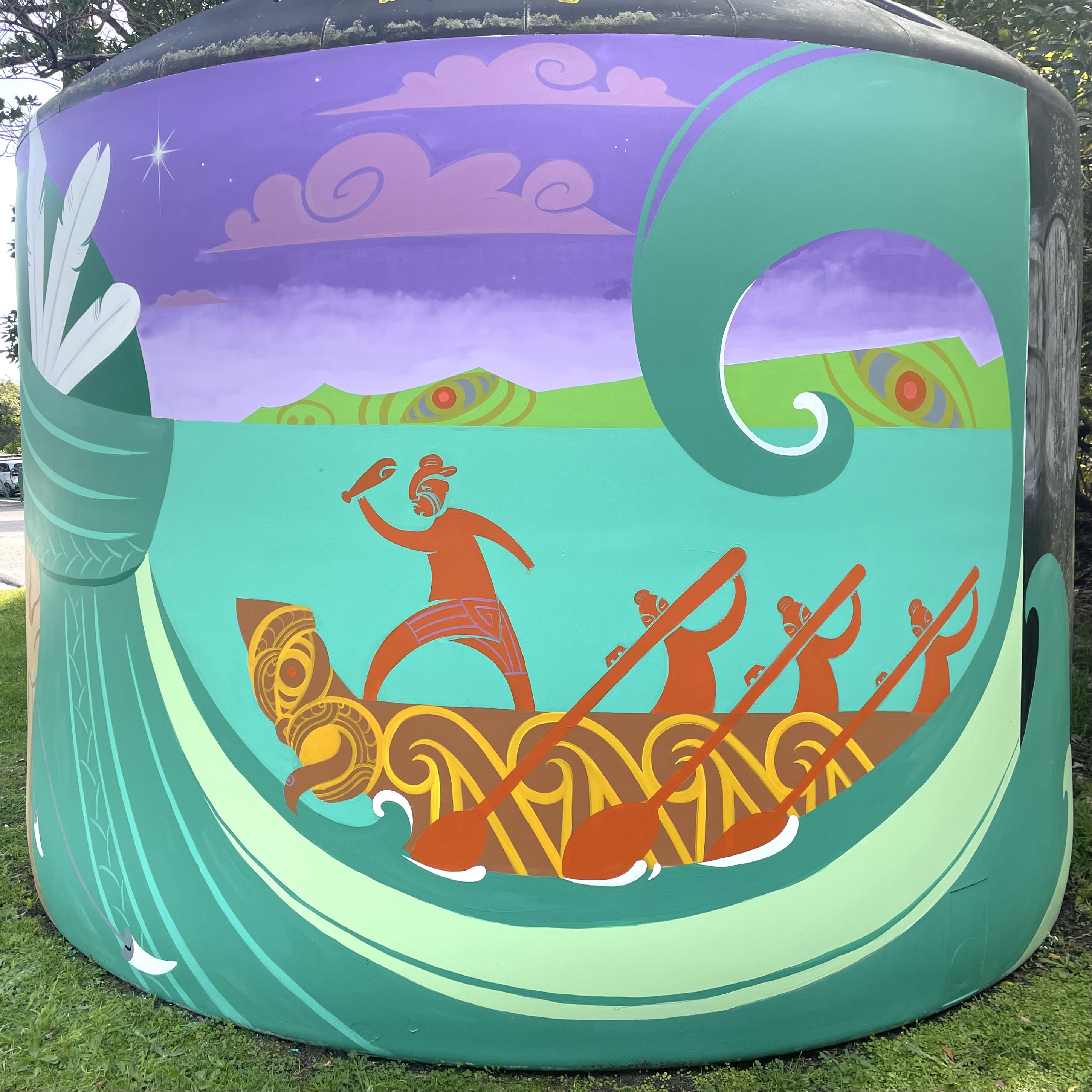- Events
- Recreation
- Transport
- Kāpiti summer
-
Kāpiti Coast Art Scene
-
Art of Kāpiti
- Frances Hodgkins murals
- He rau ringa e oti ai – Many hands make light work
- Kotahitanga
- Kāpiti Captured and Under Kāpiti Captured
- Metamorphic
- Paekākāriki water tank and wharepaku
- Paraparaumu Transport Hub bus shelters
- Pearl and Florrie's Way
- Te Horo Beach mural
- Te Raranga Whare
- Tohorā
- Tuna Heke
- Art cabinets
- What's on in our exhibition spaces
- Kāpiti Coast Art Trail
-
Art of Kāpiti
- Heritage
- Our towns
Paekākāriki water tank and wharepaku
A new commission by the Paekākāriki Community Board resulted in vibrant new murals in Paekākāriki, to complete a set of murals by leading muralist Miriama Grace-Smith (Ngāti Hau, Ngāti Maniapoto, Te Arawa, Ngāti Toa Rangatira and Ngāti Porou).
Leading from the water tank at the southern approach to Paekākāriki, to the Holtom building and the wharepaku in the village, these bright murals tell the stories of key Paekākāriki figures in legend and history, and of life and play in the village.
Kahe Te Rau-o-te-rangi


This mural tells the story of Māreikura Kahe Te Rau-o-te-rangi. Kahe was the daughter of Te Matoha (Ngāti Toa) and Te Hautonga (Ngāti Mutunga, Te Āti Awa). While living on Kāpiti Island, Kahe was warned by her attendant of an ominous vision, in which he had seen an invading army assembling and advancing on Kāpiti Island in their waka. After several days of waiting, this vision was confirmed to be true. Kahe consulted the tohunga, who told her to swim unseen to the mainland to raise the alarm and bring reinforcements. She strapped her young child Ripeka on a thick mat of raupo and swam the 6 kilometres from Kāpiti Island to Te Uruhi, south of the Waikanae River mouth. There she raised the alarm, although when reinforcements arrived at Kāpiti, the invaders had already been seen off.
In commemoration of her epic swim, the stretch of water between Kāpiti and the mainland is now known as Te Rau-o-te-rangi.
In this mural Kahe is seen standing strong between the stretch of water that is named after her, between Kāpiti and the mainland. This can be seen straight ahead if you were to walk along the beach where this mural sits. She leads the waka taua back to Kāpiti Island; in front of her is Ngāti Toa kaitiaki, the white ruru Kopa. She is adorned in red kōkōwai oil that protects her swimming and keeps her warm. Three feathers in her hair represent her Āti Awa whakapapa and the bright star on her left is a symbol, acknowledging her daughter Ripeka. Her earrings are mako teeth and the whakairo pattern on the waka is pūhoro, both representing speed, swiftness and agility.
The kaitiaki seen in Kāpiti is our great navigator Kupe, with wheke-like arms he holds a hoe, Oar. Legend tells us Kupe chased the giant wheke (octopus), Muturangi, with his oar and cut the Te Rau-o-te-rangi channel between Paraparaumu and Kāpiti Island.
Kei roto i te mahi toi nei te kōrero mō Māreikura Kahe Te Rau-o-te-rangi. He tamāhine a Kahe nā Te Matoha (Ngāti Toa) rāua ko Te Hautonga (Ngāti Mutunga, Te Āti Awa). Nō Kahe e noho ana ki te motu o Kāpiti, ka whakaohititia ia e tana mōkai ki tētahi matakitenga ōna mō te ekenga mai o tētahi kāhui waka taua ki runga o Kāpiti. Ka pau ētahi rā, kātahi ka hua mai taua matakitenga rā. Ka kīia a Kahe e tētahi tohunga kia kauhoe puku atu ki tuawhenua ki te whakaara ake i te iwi kia tae mai he tānga hei hāpai. Ka herea tana tamāhine ki tētahi whāriki raupō, ā, ka kauhoe ia mai i Kāpiti ki Te Uruhi, i te taha tonga o te pūwaha o te awa o Waikanae. Ahakoa i whakaarahia tōna iwi, nō tō rātou taenga ki Kāpiti, kua kauparea kētia te hoa riri.
Hei tohu mahara mō tana kauhoe whakamīharo, ka tapaina te wai i waenga o Kāpiti me te tuawhenua ki tōna ingoa, arā, Te Rau-o-te-rangi.
I te mahi toi nei, ka kitea a Kahe e tū marohi ana i taha o te wai kua mau ki tōna ingoa. Ka kitea tēnei mēnā ka kotahi atu tō hīkoi ki te taha moana e noho nei tēnei mahi toi. E ārahi ana ia i te waka taua ki te motu o Kāpiti. Kei mua i a ia, ko te kaitiaki o Ngāti Toa, arā, a Kopa, he ruru mā. Kua pania ia ki te kōkōwai, e haumaru ai ia nōna e kaukau ana, hei whakamahana hoki i a ia. Ko ngā huruhuru i ōna makawe, ka tohu i tōna taha Te Āti Awa, ā, ko te whetū pīataata kei tōna taha, hei tohu i tāna tamāhine, a Ripeka. Ko ōna whakakai taringa, he niho mako, ā, ko te tohu o runga i te waka he pūhoro, e tohu nei i te tere, i te kakama.
Ko te kaitiaki ka kitea i roto o Kāpiti, ko te kaiwhakatere waka rongonui, a Kupe. Me he ringa wheke ōna ringa e pupuru ana i tētahi hoe. E ai ki te kōrero, i whāia e Kupe te wheke nui, a Muturangi, me tana hoe, ā, i tāraia e ai a Te Rau-o-te-rangi i waenga i a Paraparaumu me te motu o Kāpiti.
Ki Tātahi ki Paekākāriki | At Paekākāriki Beach
Set in the modern day, this mural depicts the fun vibes people experience at Paekākāriki Beach – visitors and those who reside here alike. You can see two flags that represent the well-known and longstanding Paekākāriki Surf Lifesaving club, and people swimming, walking and playing on the shore.
Nō ēnei rā tonu, ka whakaatu te mahi toi nei i te pārekareka ka rongohia e te tangata i te tahatai o Paekākāriki - e ngā manuhiri me ngā tāngata nō konei hoki. Ka kitea hoki ngā haki e rua e tohu nei i te Karapu Manapou Takutai rongonui, tautini hoki o Paekākāriki, ā, ka kitea hoki ngā tāngata e kauhoe ana, e hīkoi ana, e tākaro ana i te tahatai.
Miriama Grace-Smith has also designed a nearby Chorus cabinet mural, Puhoro, which you can find out more about on our Art cabinets page.



